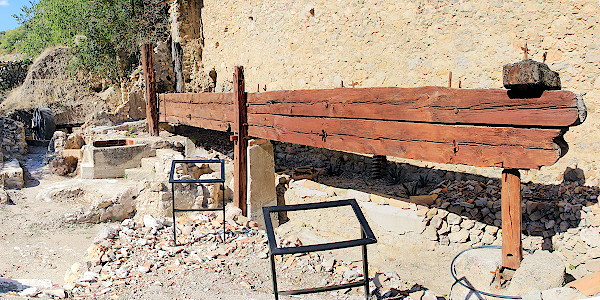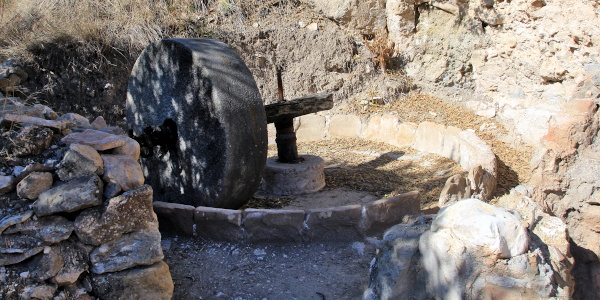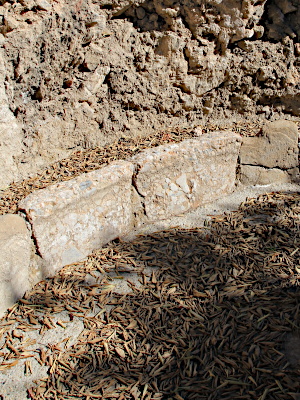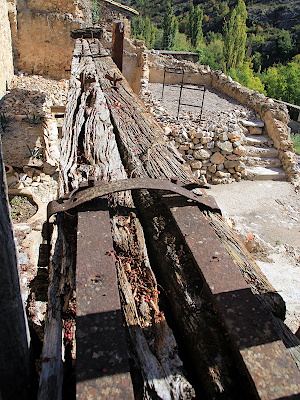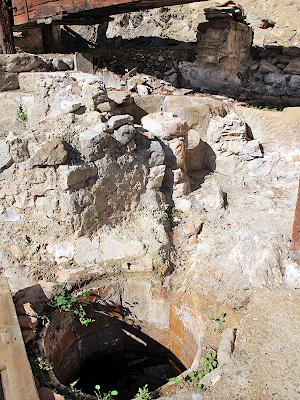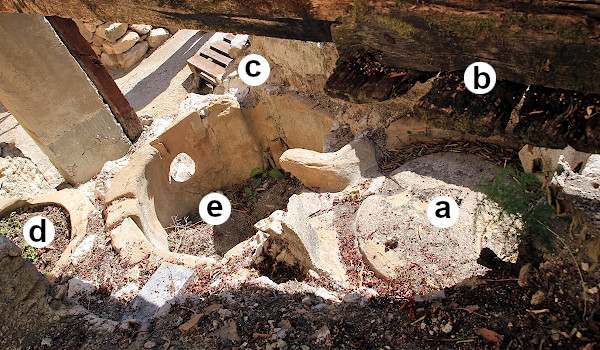Thanks to the initiative, and the hard work, of villagers of Aguinalíu
who form the association
Aguinalíu Activa, the site of the almazara which was
almost entirely hidden below debris and vegetation (see our
report from 2013)
has now been cleaned up (1). We can now easily appreciate the layout of the site and the characteristics of the equipment.
The place is dominated by the impressive cantilever press, but there is more
to discover. From left to right in (1) we recognize first the zone where the olives were crushed (see also 2, 3).
Then comes the fireplace with at its right side the vessel for hot water (4). Then we have the press with its accompanying
decanting vessels (5 – 7). Finally comes the weight stone, quintal
, with the wooden screw.
The zona de trituración (2) , the place where the
olives were crushed, occupied a separate space in the construction. The diameter of the grinding zone is 360 cm which is at the high end of the range; most platforms measure less. The edge stone measures 150 cm ∅
which is tall, but sligthly smaller than the 160 cm found in a few other mills
(e.g.
Banastón,
Buera – Los Corrales).
The edge of the grinding area (3) certainly merits a closer look. The ridge is built from conglomerate stone which is carefully cut to size. Notice that the stones are more or less wedge-shaped. The top is thickest and the stones gradually become thinner towards the ground.
Oil mills need hot water for the extraction process and
therefore a fireplace with a watervessel is always present. What
I think must have been the fireplace (4) is situated in the main room
next to the press (near the pivot point).
Next to the fire a vessel was built from concrete and lined
with red enamelled tiles (4) on the inside. It is remarkable that the top edge is provided with two gutters that would direct the overflowing water exactly to the feet of someone who is working on the fire.
Some steps leading to the platform of the press are also present (4 right, 1 left).
The main beam of the press (1, 5) is composed from 4
smaller beams. Four is the most common number, though it happens that the beam is composed of 6 (like in
Mas de Ribera – Arén) or only 2 (like in
Castarlenas) smaller beams.
Sometimes the logs undergo only minimal
trimming, but here each beam is exceptionally well debarked, edged and trimmed.
Near the pivot point the composition is reinforced
with metallic straps forming kind of a harness (5).
The
marrano (7b) is heavily weathered and it is difficult to
appreciate its original shape, but it was likely a simple square plane; not a dish like in several other mills.
The marrano brings the pressure of the cantilever over on the heap of mats loaded with olive paste.
This heap was placed on the regaifa (7a), which is a circular stone with a gutter on its perimeter
and a spout that drains the mixture of oil and water into a first decanter vessel (7e).
Through a short gutter (7c, 6) the oil flows from the first vessel (7e) over into another container which is dug into the floor of the workplace (6, below the pallet next to 7c). This vessel (6) is lined with red enamel tiles.


